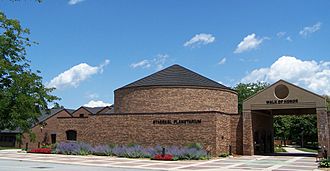Staerkel Planetarium facts for kids
Quick facts for kids William M. Staerkel Planetarium |
|
|---|---|

Exterior of the William M. Staerkel Planetarium
|
|
| General information | |
| Type | Planetarium |
| Address | 2400 W Bradley Ave |
| Town or city | Champaign |
| Country | United States |
| Opened | 1987 |
| Affiliation | Parkland College |
The William M. Staerkel Planetarium is a cool place to learn about space at Parkland College in Champaign, Illinois. It's the second largest planetarium in Illinois, right after the Adler Planetarium in Chicago. This planetarium was the very first place in the Western Hemisphere to get a special Carl Zeiss M1015 star projector.
Every year, the Staerkel Planetarium teaches science to about 40,000 people. They also put on fun light shows! The main room has a huge 50-foot dome and can seat 144 people. You can visit during public shows, or groups and schools can book their own special visits. Public shows happen every Friday and Saturday evening. They also have a lecture series on the first Friday of each month.
The planetarium is named after William M. Staerkel. He was the first president of Parkland College and led it for 20 years.
Contents
History of the Staerkel Planetarium
The idea for the William M. Staerkel Planetarium started a long time ago, back in the late 1960s. It was planned as part of a new cultural center at Parkland College. This center included both a theater and the planetarium. Building both parts cost about $4.2 million.
The planetarium was officially named after Dr. William M. Staerkel on October 1, 1987. He was the college's first president and helped make the dream of the cultural center come true. The planetarium opened its doors to the public on October 22, 1987.
What Equipment Does the Planetarium Use?
The Amazing Zeiss Model M1015 Projector
The main star of the planetarium is its Zeiss Model M1015 star projector. This incredible machine was made by Carl Zeiss, Inc. in Germany. It was the first of its kind to be used anywhere in the world!
This projector can show you 7,600 stars, even faint ones. It also projects 25 star clusters and nebulae, the sun, the moon, and the five planets you can see without a telescope. The Zeiss can show how the sky moves each day and where stars are on almost any date. It can even project rainbows, clouds, eclipses, and spinning galaxies!
Other Cool Equipment
The planetarium has more than just the Zeiss projector. It has a huge dome, special computers, and awesome sound and film systems.
The Dome: A Giant Screen
The projection dome is 50 feet wide and 31 feet tall at its highest point. It's made of special aluminum panels held together by 7,000 rivets. What's really cool is that it has about 43 million tiny holes! These holes help the sound travel perfectly and allow speakers and special effects to be placed behind the dome.
Computers, Sound, and Film
The planetarium uses a special computer called the MC-10 Media Controller. This computer helps run the shows automatically using programmable disks. The sound system is super powerful, with a recording studio and 12 speakers plus two huge sub-bass speakers behind the dome.
They can also show 35mm films that cover more than one-third of the dome! Besides the main star projector, there are 57 carousel slide projectors that can show panoramas across the entire dome. Plus, three CRT projectors show videos and special effects.
Fun Things to See in the Lobby
Before you even enter the main dome, there are cool things to explore in the lobby!
The Solar Window
The solar window is a beautiful piece of art given to the planetarium in 1987. It was created by artist Arthur Stern. This window shows how the sun's path changes in the sky throughout the year. The top of the window represents June, when the sun is highest and days are longest. The bottom represents December, when the sun is lowest and days are shortest.
When sunlight shines through the window, tiny prisms inside split the light into all the colors of the rainbow. These colorful patterns, called spectra, move slowly across the building as the sun moves across the sky.
“Cosmic Blink” Mural
The "Cosmic Blink" mural is a huge painting in the lobby. It was painted by Billy Morrow Jackson, an artist from the University of Illinois at Urbana-Champaign. This mural shows how people have always tried to understand the universe.
You can see celestial objects, old constellation figures, modern space explorers, and even images sent back from space. The mural also honors smart people who helped us learn about the universe. It even includes Dr. Staerkel and students and teachers from Parkland College, showing that the quest to understand space continues right there!
Shows and What's On Schedule
The Staerkel Planetarium offers many shows for schools and the public. They also do outreach programs for schools, libraries, and other groups.
Public shows are usually held on Friday and Saturday evenings, except for holidays. They even have late-night rock-n-roll light shows with their powerful 3,000-watt sound system!
The planetarium also hosts science lectures as part of the World of Science Lecture Series. These happen on the first Friday of each month during Parkland College's Spring (February, March, April) and Fall (October, November, December) semesters. Sometimes, the planetarium even hosts live music performances from unique groups like Stars of the Lid.


